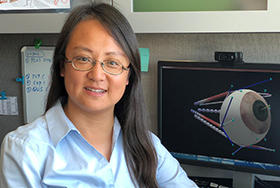In This Story

The human eye may soon see faster diagnosis with machine learning, or AI. Through algorithms, AI can potentially assess eye alignment problems quickly, resulting in better treatment of double vision.
This is a recent finding from a $1.8 million research grant funded by the National Institutes of Health. Qi Wei, an associate professor in the Department of Bioengineering at George Mason University, is one of four principal investigators researching treatments for strabismus and double vision through the grant.
In a previous article that introduced the grant, Wei is helping to develop a data-driven computer model of the eye for diagnosing and treating strabismus. Applying machine learning is an exciting new development, she says.
“From an engineering perspective, the use of machine learning leverages and integrates data on a higher level,” says Wei. “It could become a tool or platform to help physicians diagnose eye problems.”
Although there is promise, it’s not necessarily an easy or immediate fix, says Wei. Usually, machine learning models work better when trained by more data. MRI is still the gold standard to confirm specific causes of strabismus, but this evaluation is not routinely obtained in most strabismic patients.
“When it comes to imaging, most eye doctors do not prescribe MRI for their patients before strabismus surgery, sometimes because of the cost of the imaging,” says Wei. “While the machine learning method for interpreting office measurements of eye alignment is not expensive, the MRI machine is.”
There is also the chance of error with AI, and a diagnosis that’s not perfectly accurate.
The use of machine learning will be further demonstrated at the annual American Association for Pediatric Opthamology and Strabismus conference in March in Scottsdale, Arizona. Along with Wei, Dr. Joseph Demer, professor of pediatric ophthalmology and professor of neurology at the University of California, Los Angeles will coordinate a diagnostic show-down where patient strabismus cases will be presented. Over 100 ophthalmologists from around the world will be invited to compare their diagnosis to the AI diagnosis in real time. Then the true reveal from a high-performance MRI scan will be disclosed. It will show if the quick draw of expert eye doctors is as accurate as computerized AI.
“We hope this is a fun and hands-on approach to test the AI theory and receive feedback from experts in the field,” says Wei.
